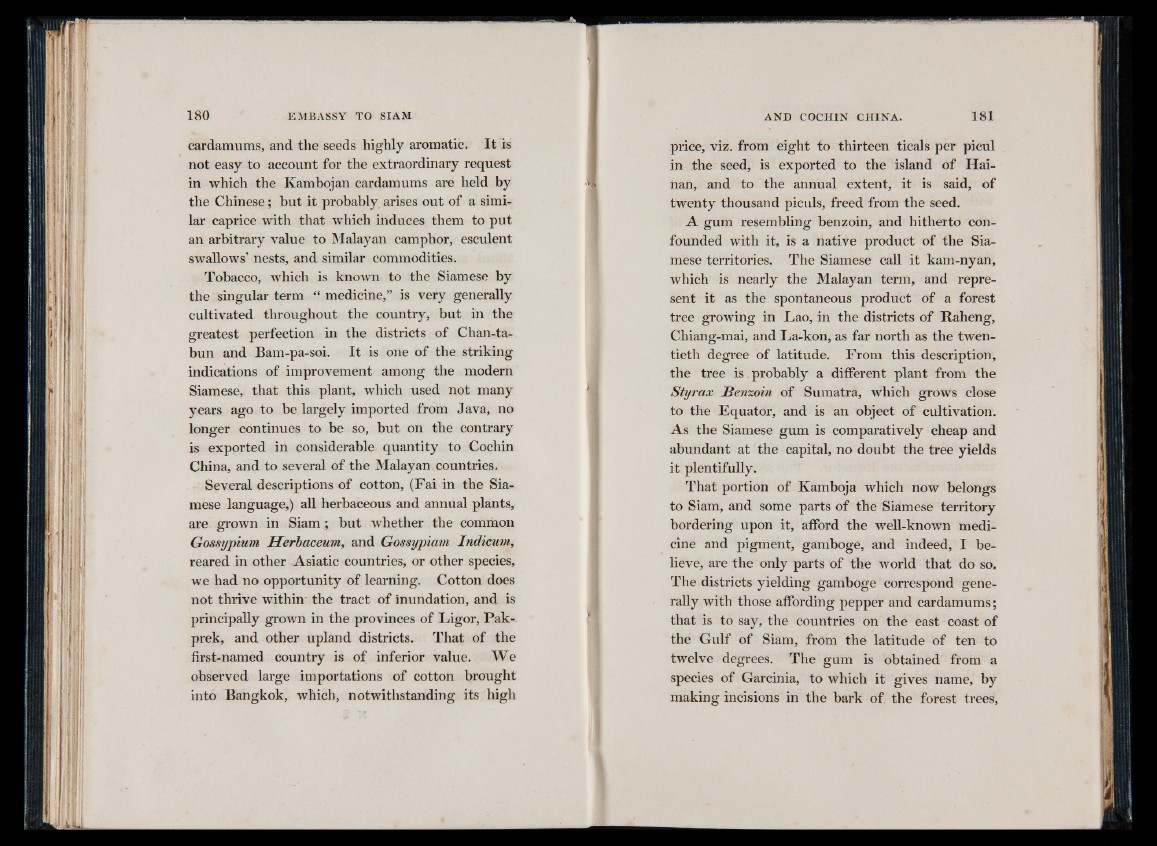
cardamums, and the seeds highly aromatic. I t is
not easy to account for the extraordinary request
in which the Kambojan cardamums are held by
the Chinese; but it probably arises out of a similar
caprice with that which induces them to put
an arbitrary value to Malayan camphor, esculent
swallows’ nests, and similar commodities.
Tobacco, which is known to the Siamese by
the singular term “ medicine,” is very generally
cultivated throughout the country, but in the
greatest perfection in the districts of Chan-ta-
bun and Bam-pa-soi. I t is one of the striking
indications of improvement among the modern
Siamese, that this plant, which used not many
years ago to be largely imported from Java, no
longer continues to be so, but on the contrary
is exported in considerable quantity to Cochin
China, and to several of the Malayan countries.
Several descriptions of cotton, (Fai in the Siamese
language,) all herbaceous and annual plants,
are grown in Siam ; but whether the common
Gossypium Herbaceum, and Gossypiam Indicum,
reared in other Asiatic countries, or other species,
we had no opportunity of learning. Cotton does
not thrive within the tract of inundation, and is
principally grown in the provinces of Ligor, Pak-
prek, and other upland districts. That of the
first-named country is of inferior value. We
observed large importations of cotton brought
into Bangkok, which, notwithstanding its high
price, viz. from eight to thirteen ticals per picul
in the seed, is exported to the island of Hainan,
and to the annual extent, it is said, of
twenty thousand piculs, freed from the seed.
A gum resembling benzoin, and hitherto confounded
with it, is a native product of the Siamese
territories. The Siamese call it kam-nyan,
which is nearly the Malayan term, and represent
it as the spontaneous product of a forest
tree growing in Lao, in the districts of Raheng,
Chiang-mai, and La-kon, as far north as the twentieth
degree of latitude. From this description,
the tree is probably a different plant from the
Styrax Benzoin of Sumatra, which grows close
to the Equator, and is an object of cultivation.
As the Siamese gum is comparatively cheap and
abundant at the capital, no doubt the tree yields
it plentifully.
That portion of Kamboja which now belongs
to Siam, and some parts of the Siamese territory
bordering upon it, afford the well-known medicine
and pigment, gamboge, and indeed, I believe,
are the only parts of the world that do so.
The districts yielding gamboge correspond generally
with those affording pepper and cardamums;
that is to say, the countries on the east coast of
the Gulf of Siam, from the latitude of ten to
twelve degrees. The gum is obtained from a
species of Garcinia, to which it gives name, by
making incisions in the bark o f the forest trees,